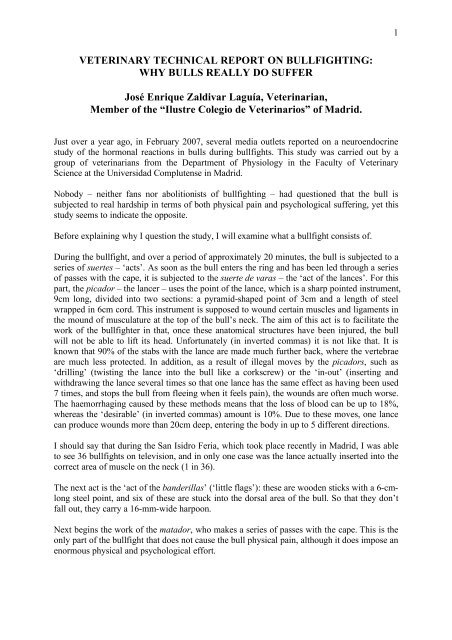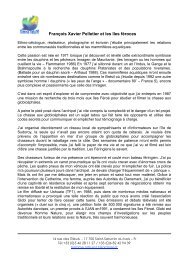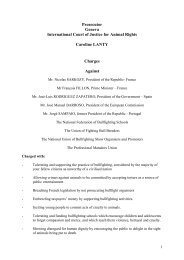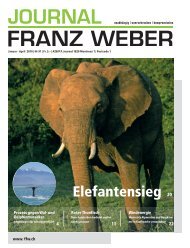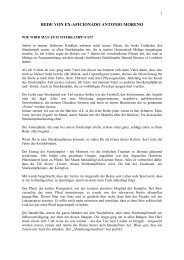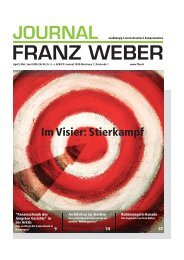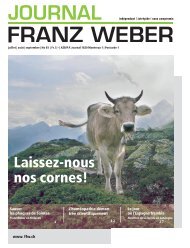VETERINARY TECHNICAL REPORT ON BULLFIGHTING: WHY ...
VETERINARY TECHNICAL REPORT ON BULLFIGHTING: WHY ...
VETERINARY TECHNICAL REPORT ON BULLFIGHTING: WHY ...
You also want an ePaper? Increase the reach of your titles
YUMPU automatically turns print PDFs into web optimized ePapers that Google loves.
<strong>VETERINARY</strong> <strong>TECHNICAL</strong> <strong>REPORT</strong> <strong>ON</strong> <strong>BULLFIGHTING</strong>:<br />
<strong>WHY</strong> BULLS REALLY DO SUFFER<br />
José Enrique Zaldivar Laguía, Veterinarian,<br />
Member of the “Ilustre Colegio de Veterinarios” of Madrid.<br />
Just over a year ago, in February 2007, several media outlets reported on a neuroendocrine<br />
study of the hormonal reactions in bulls during bullfights. This study was carried out by a<br />
group of veterinarians from the Department of Physiology in the Faculty of Veterinary<br />
Science at the Universidad Complutense in Madrid.<br />
Nobody – neither fans nor abolitionists of bullfighting – had questioned that the bull is<br />
subjected to real hardship in terms of both physical pain and psychological suffering, yet this<br />
study seems to indicate the opposite.<br />
Before explaining why I question the study, I will examine what a bullfight consists of.<br />
During the bullfight, and over a period of approximately 20 minutes, the bull is subjected to a<br />
series of suertes – ‘acts’. As soon as the bull enters the ring and has been led through a series<br />
of passes with the cape, it is subjected to the suerte de varas – the ‘act of the lances’. For this<br />
part, the picador – the lancer – uses the point of the lance, which is a sharp pointed instrument,<br />
9cm long, divided into two sections: a pyramid-shaped point of 3cm and a length of steel<br />
wrapped in 6cm cord. This instrument is supposed to wound certain muscles and ligaments in<br />
the mound of musculature at the top of the bull’s neck. The aim of this act is to facilitate the<br />
work of the bullfighter in that, once these anatomical structures have been injured, the bull<br />
will not be able to lift its head. Unfortunately (in inverted commas) it is not like that. It is<br />
known that 90% of the stabs with the lance are made much further back, where the vertebrae<br />
are much less protected. In addition, as a result of illegal moves by the picadors, such as<br />
‘drilling’ (twisting the lance into the bull like a corkscrew) or the ‘in-out’ (inserting and<br />
withdrawing the lance several times so that one lance has the same effect as having been used<br />
7 times, and stops the bull from fleeing when it feels pain), the wounds are often much worse.<br />
The haemorrhaging caused by these methods means that the loss of blood can be up to 18%,<br />
whereas the ‘desirable’ (in inverted commas) amount is 10%. Due to these moves, one lance<br />
can produce wounds more than 20cm deep, entering the body in up to 5 different directions.<br />
I should say that during the San Isidro Feria, which took place recently in Madrid, I was able<br />
to see 36 bullfights on television, and in only one case was the lance actually inserted into the<br />
correct area of muscle on the neck (1 in 36).<br />
The next act is the ‘act of the banderillas’ (‘little flags’): these are wooden sticks with a 6-cmlong<br />
steel point, and six of these are stuck into the dorsal area of the bull. So that they don’t<br />
fall out, they carry a 16-mm-wide harpoon.<br />
Next begins the work of the matador, who makes a series of passes with the cape. This is the<br />
only part of the bullfight that does not cause the bull physical pain, although it does impose an<br />
enormous physical and psychological effort.<br />
1
The bullfight concludes with the estocada, the plunging of an 80-cm-long curved sword into<br />
an exact spot between the shoulder blades, causing the death of the bull. However, more often<br />
than not, the sword thrust misses this spot, where it has the desired effect of cutting the main<br />
blood vessels. Instead, it usually wounds the nerve cords lateral to the spine, disconnecting<br />
the thoracic cage and causing massive injury to the lungs. Blood can flow from the lungs to<br />
the bronchi and from there to the trachea, exiting via the mouth and nose, sometimes in huge<br />
quantities. On other occasions, the sword thrust is so low that it can perforate the diaphragm<br />
and even the stomach and liver. If this happens, the bull will die swallowing its own blood.<br />
It ends with the descabello and the puntilla. The descabello is carried out with a sword<br />
similar to the one used for the estocada, but with a 10cm crosspiece; it consists of severing<br />
the spinal cord at the intervertebral space between the first and second cervical vertebrae. The<br />
puntilla is the ‘coup de grace’, ensuring the final death of the bull, and has the same aim as<br />
the descabello, but is carried out with a 10-cm knife.<br />
In the study that we refer to, the hormone levels in the following different groups of bulls<br />
were analysed:<br />
1-Bulls that have only been transported by lorry.<br />
2-Bulls that go out into the ring but are sent back to the pens because of some physical<br />
problem, without going through any of the ‘acts’ described above.<br />
3-Bulls that have been wounded with the lance and then sent back to the pens.<br />
4-Bulls that have been wounded with the lance and banderillas and then sent back to the pens.<br />
5-Bulls that go through all the stages of the bullfight and therefore die in the ring.<br />
We believe that the biggest groups are 1 and 5, as the circumstances described in groups 2, 3<br />
and 4 are relatively rare. I say ‘believe’, because the study has still not been published in a<br />
scientific journal, nearly a year and a half after being made public.<br />
The study was based on measuring the following series of hormones:<br />
1. ACTH: a hormone produced in the pituitary gland and a precursor to cortisol.<br />
2. Cortisol: a hormone produced in the adrenal glands.<br />
3. Beta-endorphins: hormones produced in various parts of the body.<br />
The study also refers to two other hormones, adrenaline and noradrenaline, which I won’t<br />
refer to here so as not to overly broaden my comparison.<br />
ACTH and cortisol are the hormones involved in an organism’s response to stress. The more<br />
that is produced, the greater the stress. Once the stressful stimulus has occurred, orders are<br />
sent by the nervous system to release these hormones.<br />
So what is stress? What is its purpose? And what health consequences does it have? Stress is<br />
defined as an ‘aggression against a living organism’ or ‘the combined biological and<br />
psychological reactions that are unleashed when an organism is suddenly confronted with a<br />
harmful agent of some kind’. It is also defined as: ‘a situation where an individual or one of<br />
its organs or systems demands higher than normal functioning, putting it at risk of illness’.<br />
So we might expect that of the bulls analysed, those in group 5 (those who have been through<br />
all the acts of the bullfight and have died in the ring) would have more ACTH and more<br />
2
cortisol in their blood than the bulls in the other groups, and of course much more than the<br />
ones in group 1. In other words, the greater the hardship, the greater the stress caused.<br />
However, according the study that we are looking at, that is not the case. According to this<br />
study, the transported bulls (group 1) and the bulls in group 2 have three times as much stress<br />
as the others, i.e. more ACTH and more cortisol. Equally, bulls from group 3 have more stress<br />
than those from group 4, and these have more than bulls from group 5.<br />
What can be happening, if this study and its conclusions are correct, and we are to believe<br />
that they are, for everything to be the opposite of what we would expect? Can it be true, as the<br />
study tells us, that a bull that is subjected to a bullfight is a neuro-endocrinologically special<br />
animal, perfectly adapted to bullfighting?<br />
What if I point out that, in order for certain endocrine responses (such as the release of<br />
cortisol through ACTH) to be measured, it is essential for the neuronal stimulus and the<br />
signal transduction in the nervous system to be intact? In other words, if a wound has<br />
damaged the nervous system, this type of hormonal response cannot be assessed, since it<br />
cannot occur normally. That being the case, what conclusion do you now draw?<br />
We know from numerous studies and papers by veterinarians specialising in bulls that the<br />
lances used in bullfighting rupture the spinal processes and thoracic vertebrae, damage blood<br />
vessels that flow to the muscles that are important for movement, and sever or injure the<br />
dorsal rami of the spinal nerves. This can (and indeed does) cause temporary limping and<br />
leads to the reflex inhibition of the brachial plexus (the nervous centre that innervates the<br />
anterior extremities). We know that the lance stabs can cause major haemorrhaging in the<br />
spinal canal and can injure the upper part of the ribs. The deepest lance wounds can even<br />
perforate the pleura and affect the lungs, causing pneumothorax and consequent respiratory<br />
failure.<br />
We know that the banderillas, through the force of gravity and the movement of the bull,<br />
cause damage to nerves, muscles and blood vessels. We know that the estocada also cuts<br />
through important nerves, and finally that the descabello and puntilla cut the spinal cord. We<br />
therefore know that the bull’s nervous system suffers significant damage during the bullfight,<br />
making a normal response impossible in terms of the release of ACTH and cortisol. It is<br />
therefore to be expected, and fits in with the conclusions of the study that we are refuting, that<br />
bulls that have only been transported or that go out into the ring and are then sent back<br />
without suffering physical harm have more cortisol than those that have suffered harm. It is<br />
not that they have more stress, just that their nervous system is intact, which, as I pointed out<br />
before, is essential for this kind of hormonal response to be taken into account and measured<br />
accurately. Did you know that in people involved in accidents with major spinal injuries, the<br />
hormonal response that would result in the release of cortisol is reduced or even absent? Can<br />
there be any more stressful situation for someone that thinking that they are going to spend<br />
the rest of their life in a wheelchair? Is there any more serious neurological damage that the<br />
severing of the spinal cord as in the descabello or puntilla? Don’t forget that the majority of<br />
bulls analysed had blood taken after death, in other words after having suffered the wounds<br />
previously described.<br />
3
The other part of the study relates to the production of other hormones called beta-endorphins.<br />
We know that these are produced by the body in situations of stress and/or pain. Given that<br />
during the bullfight the bull apparently releases an enormous quantity of these, it is concluded<br />
that these beta-endorphins would be capable of cancelling out the pain that the bull is caused.<br />
We are told that the bull releases ten times the quantity of beta-endorphins as humans. But<br />
under what circumstances? No human being has been, nor ever will be, subjected to a<br />
bullfight. To make such assertions, the species compared should be subjected to the same<br />
circumstances, and this is not the case, nor ever will be. In addition, in the majority of cases,<br />
the hormone levels were measured in blood taken from dead bulls, so it is impossible to say at<br />
what point in the bullfight the hormones were released. Was it after the lance wounds, as the<br />
authors maintain? Or after the banderillas? And why not after the descabello or puntilla?<br />
Since a series of blood samples was not taken, for the time being, we cannot know. It would<br />
be necessary to stop the bullfight at various stages to know at what exact moment such a large<br />
amount of hormones was released as to minimize the animal’s pain.<br />
I should also point out that properties are attributed to beta-endorphins that they do not<br />
actually possess. They are supposed to neutralise pain, whereas in fact the most we can say is<br />
that they alleviate it. What is certain is that they act as mediators, and most importantly they<br />
mediate pain and stress. I have not come across a single study that maintains that they<br />
neutralise pain, or that an organism can instantaneously stop feeling pain that is being<br />
inflicted on it due to their effect. And we are not talking about trivial pain; at least, I, as a<br />
veterinarian, cannot call the pain that bulls suffer in bullfighting trivial. A large number of<br />
studies in women during childbirth (where samples were taken sequentially) have shown that<br />
the higher the level of beta-endorphins, the greater the pain experienced. The women who<br />
said that labour had been unbearable were the ones that showed the highest levels of betaendorphins,<br />
and, interestingly, the newborns that had suffered the most during birth were the<br />
ones that had the most beta-endorphins in their blood. And one important fact: women who<br />
had attended ante-natal classes, whose stress levels were lower, had lower levels of betaendorphins.<br />
How is it possible that levels of stress hormones like cortisol can be almost normal in bulls<br />
after the bullfight, and that other hormones, beta-endorphins, also mediators of stress, can be<br />
so high? In my opinion the answer lies in the integrity of the nerve structures, since it is<br />
known that when there is neurological damage, beta-endorphins can be released at the site of<br />
the pain, due to certain cellular mechanisms, without the involvement of the nervous system.<br />
My conclusions in respect of the study that we have been looking at are therefore clear:<br />
The hormonal responses in relation to stress are the ones expected, given the neurological<br />
damage that the bull suffers during the bullfight, and are caused by the lance stabs, the<br />
banderillas, the estoque, the descabello, the puntilla, and finally the exhaustion that the<br />
animal undergoes (general adaptation syndrome). This syndrome has been studied over many<br />
years and is still very relevant here. It means that in a situation were there is a threat to the<br />
body’s equilibrium, all organisms respond by trying to adapt. It can therefore be described as<br />
the body’s specific physiological response when faced with a demand or aggression, whether<br />
physical or psychological. What is certain is that when the aggression is repeated frequently<br />
or takes place over an extended period of time, and when the animal’s resources to achieve<br />
4
the level of adaptation are inadequate, it goes from the adaptation stage to the exhaustion<br />
stage, where hormonal responses to stress are impossible.<br />
Hormonal responses to pain, i.e. the release of large quantities of beta-endorphins such as are<br />
found in the blood of bulls after a bullfight, are an organism’s normal response to great pain<br />
and stress, and have very little to do with its capacity to neutralise it; in fact, on the contrary,<br />
the hormone levels indicate the level of pain experienced, not the animal’s ability to cancel it<br />
out.<br />
José Enrique Zaldivar Laguía,<br />
Veterinarian,<br />
Member of the “Ilustre Colegio de Veterinarios” of Madrid.<br />
5


